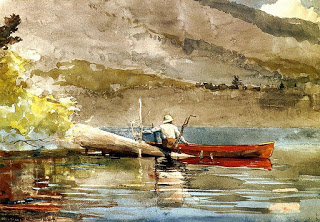I am reading a book entitled "Moonwalking with Einstein. The Art and Science of Remembering Everything" by Joshua Foer. The title is self-explanatory, the style is highly readable as Foer is a seasoned writer for such publications as the New York Times, National Geographic, Slate, etc. The content is totally fascinating - about how science is slowly understanding better how the human brain works, especially in terms of memory.
I still have many pages to go, but one page started me thinking about the parallels between artists and the master chess players that Foer was discussing. In the 1940s, Adriaan de Groot, a Dutch psychologist and chess player, decided to investigate what separated a good chess player from a master chess player - what was going on in their heads? Were the top players able to think further ahead in their moves, did they have better mental tools or a more honed intuition for the game? From past high level games,De Groot selected a series of board positions where there was one correct move to make which was not all that obvious. He then asked a group of top flight chess players to ponder these boards and to think aloud as they selected the proper move.
To De Groot's astonishment, the players mostly did not think many moves ahead, nor did they consider more possible moves. What they did was to see the right move, and almost immediately. After analysing the players' commentaries, De Groot realised that the chess experts were reacting, rather than thinking, and they could do this because their long experience of playing had taught them to think about "configurations of pieces like 'pawn structures' and immediately noticed things that were out of sorts, like exposed rooks". They had learned to see the whole chess board and thirty-two chess pieces as systems and groups. Later studies of top players' eye movements confirm that they literally see a different chess board, for they see more edges of the squares, which means they are encompassing whole areas at once. They also move their eyes across greater distances, without lingering for long at any one spot. Those places on which they do focus tend to be the key areas linked to making the right move.
This description of how master chess players function made me think of artists who have honed their skills day after day, year after year. Their eye-hand coordination has been perfected, their senses of composition/design, colour and content are developed. When they draw a nude, for instance, or work on a landscape painting plein air, for instance, they are not looking at just one spot. Rather, they are encompassing the whole so that almost intuitively, they can adjust their composition, their values and colour in the work for the best results. Their powers of observation and concentration are almost unthinking, because they are trained and disciplined.
The Red Canoe, 1889, watercolour, Winslow Home (Image courtesy of the Peabody Art Collection, Baltimore, Maryland)
To me, Winslow Homer is an example of a highly skilled painter, producing amazingly fresh landscapes, frequently plein air, and often in watercolour. One such example is "The Red Canoe" (image courtesy of the Peabody Collection, the Athenaeum).
Foer goes on to comment on the master chess players' amazing memories. I suspect that the great artists, past and present, also intrinsically rely on their memories quickly to understand a subject after a brief moment of studying it, Like the chess players, they can also call upon past experiences to bolster and inform their present work. The saying, "Been there, done that" applies, in a very positive sense, to an artist as well as chess players. Perhaps one should just add, "umpteen times"!
